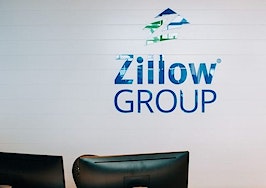Zillow’s revenue continued to explode due to the growth of its homes segment, according to the company’s first-quarter earnings report Thursday.
Zillow posted $1.1 billion in revenue for the first quarter, more than double the $454.1 million in revenue it posted in 2019 and ahead the consensus estimate of $1 billion in revenue.
Zillow posted a net loss of $163 million. The company also broke down its net losses by segment, posting a net loss of $41.5 million, $98 million and $13.1 million for the IMT (internet, media & technology), homes and mortgages segments, respectively.
“During Q1, we learned the true value of home,” Zillow CEO Rich Barton said in a statement. “We also learned real estate is resilient as we’re seeing clear signals that people are still shopping for homes and want to move.”
“Our Q1 results met or beat our outlook on all measures despite some volatility in the second half of March,” Barton said. “We started the year strong, coming off a solid 2019 and ended the first quarter with an even stronger balance sheet, including a record cash balance.”
The full picture of the impact COVID-19 has had on the business is not immediately clear, as the first quarter numbers only run through March 31, but Zillow, in March, took a number of proactive measures to cut costs and assist its clients.
The company announced in mid-March it would cover half the cost of the agent advertising platform Premier Agent for its existing customers, at an expected cost of $40 to $50 million.
On a call with investors in late March, Barton announced the company would take four specific actions to cut 25 percent of the company’s quarterly expense run rate: pause hiring, cut most of its marketing spend, halt home acquisitions through Zillow Offers and reduce discretionary spending.
Zillow Homes — the segment of the business under which Zillow Offers, the company’s homebuying and selling platform, exists — generated $770 million revenue, the most since the platform was launched. That segment of the business operated at net loss of $98 million before income taxes.
Zillow sold 2,394 homes and purchased 1,479 homes through Zillow Offers in the first quarter. It ended the quarter with 1,791 homes in inventory, down from 2,707 at the end of the fourth quarter. Slashing inventory was an intentional strategic decision, the company said.
The company lost, on average, $4,478 per home it sold in the first quarter of 2020.
“The inventory decline was primarily due to our sales velocity outperformance as our pause of Zillow Offers’ home acquisitions, that began on March 23, 2020, had minimal impact on ending inventory late in the quarter,” Barton said.
Zillow’s IMT revenue was up 11 percent to $331 million, fueled by improved Premier Agent performance, Barton said, in an accompanying letter to shareholders. Some of the revenue gains from the switch to flex pricing is delayed, due to the shift in model, where agents pay Zillow after closing.
“The accelerated revenue growth was due to a combination of a substantial increase in connections, increased customer and agent satisfaction, continued focus on working with higher-performing agents, and tailwinds from a favorable housing market during January and February,” Barton said.
The company’s stock has fluctuated significantly like many other publicly-traded companies since the start of the pandemic and introduction of state-by-state lockdown orders. In late February, it reached as high as $65 per share, before falling as low as $23.51 per share in March.
It closed the trading day Thursday at $48.19 per share.
Barton, in a statement, was bullish about the company’s future in a world of social distancing, due to its investment in virtual tools services.
“There is light on the horizon, and we’re well-positioned to move faster to the future, offering our customers and partners innovative products and services, such as our proprietary 3D Home Tours, to enable seamless and safe transactions in a more virtual world,” Barton said. “The virtual tools home shoppers need for safety today will become their expectations for convenience tomorrow.”
Developing…







